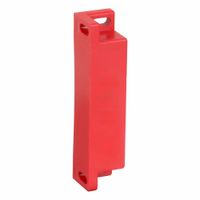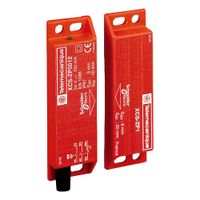Call +(254) 703 030 000 / 751 483 999 / 721 704 777
- Home
- Electrical
- Industrial Controls Automation And Machine Safety
- Machine Safety
- Magnetically Actuated Safety Interlock Switches
.....Read More
Frequently Asked Questions
What are magnetically actuated safety-interlock switches?
Magnetically actuated safety-interlock switches are devices used to ensure the safe operation of machinery by preventing access to hazardous areas unless certain conditions are met. These switches are part of safety systems designed to protect operators and equipment by interrupting power or control signals when a guard or door is opened.
The switch consists of two main components: a magnetic actuator and a switch body. The magnetic actuator is typically mounted on a movable guard, door, or panel, while the switch body is fixed to the stationary part of the machine. When the guard is closed, the magnetic actuator aligns with the switch body, allowing the magnetic field to actuate the switch. This alignment completes an electrical circuit, enabling the machine to operate.
If the guard is opened, the magnetic field is disrupted, causing the switch to open the circuit and stop the machine or trigger an alarm. This interruption ensures that the machine cannot operate while the guard is open, preventing accidental access to dangerous areas.
Magnetically actuated safety-interlock switches are non-contact devices, meaning they do not require physical contact between the actuator and the switch body. This feature reduces wear and tear, enhances reliability, and allows for some misalignment between the components. They are often used in environments where dust, dirt, or moisture might affect traditional mechanical switches.
These switches are commonly used in industries such as manufacturing, packaging, and food processing, where safety and hygiene are critical. They comply with international safety standards and are available in various designs to suit different applications, including coded magnetic switches that offer higher tamper resistance by using unique magnetic codes.
How do magnetic safety-interlock switches work?
Magnetic safety-interlock switches are devices used to ensure that machinery operates only when safety conditions are met. They consist of two main components: a magnetic actuator and a switch. The actuator is typically attached to a movable part, such as a door or guard, while the switch is mounted on the stationary part of the machine.
When the door or guard is closed, the magnetic actuator aligns with the switch, creating a magnetic field that closes the circuit within the switch. This closed circuit sends a signal to the machine's control system, indicating that it is safe to operate. The machine can then start or continue its operation.
If the door or guard is opened, the magnetic actuator moves away from the switch, disrupting the magnetic field. This action opens the circuit, sending a signal to the control system to stop the machine or prevent it from starting. This interruption ensures that the machine cannot operate when safety barriers are not in place, protecting operators from potential hazards.
Magnetic safety-interlock switches are often used in environments where dust, dirt, or moisture might affect mechanical switches, as they have no physical contact points that can wear out or become contaminated. They are also valued for their reliability and ease of installation.
These switches can be configured in various ways, such as normally open (NO) or normally closed (NC), depending on the specific safety requirements. They may also include additional features like LED indicators for status monitoring or multiple contacts for complex safety circuits.
Overall, magnetic safety-interlock switches provide a simple yet effective means of ensuring that machinery operates only under safe conditions, thereby enhancing workplace safety.
What are the benefits of using non-contact safety switches?
Non-contact safety switches offer several benefits:
1. **Enhanced Safety**: They provide a high level of safety by ensuring that machinery cannot operate unless safety guards are in place, reducing the risk of accidents.
2. **Durability**: With no physical contact, these switches are less prone to wear and tear, leading to a longer lifespan and reduced maintenance costs.
3. **Flexibility**: They can be used in a variety of applications and environments, including those with high levels of dust, dirt, or moisture, where traditional contact switches might fail.
4. **Ease of Installation**: Non-contact switches are generally easier to install and align, as they do not require precise physical contact, saving time and effort during setup.
5. **Reduced Downtime**: Their robust design and resistance to environmental factors mean fewer failures and less downtime for maintenance or repairs.
6. **Hygienic**: Ideal for industries like food and pharmaceuticals, where hygiene is critical, as they do not accumulate contaminants like contact-based switches.
7. **Versatility**: Available in various types, such as magnetic, RFID, and inductive, they can be tailored to specific needs and safety requirements.
8. **Tamper Resistance**: Many non-contact switches are designed to be tamper-proof, ensuring that safety protocols cannot be easily bypassed.
9. **Compact Design**: Their small size allows for integration into tight spaces without compromising safety.
10. **Cost-Effective**: While the initial cost may be higher, the long-term savings from reduced maintenance and downtime make them a cost-effective solution.
Overall, non-contact safety switches provide a reliable, efficient, and versatile solution for ensuring safety in industrial environments.
Where are magnetic safety-interlock switches typically installed?
Magnetic safety-interlock switches are typically installed in industrial and commercial settings where machinery or equipment poses potential safety hazards. These switches are commonly found on:
1. **Machine Guards and Safety Doors**: They are installed on protective barriers, doors, or covers of machinery to ensure that the machine cannot operate unless the guard is in place. This prevents accidental exposure to moving parts.
2. **Access Panels and Enclosures**: Used on access panels of electrical enclosures or control cabinets to ensure that power is cut off when the panel is opened, protecting maintenance personnel from electrical hazards.
3. **Conveyor Systems**: Installed on conveyor system gates or hatches to stop the conveyor when the gate is opened, preventing injury from moving parts.
4. **Robotic Cells**: Used in robotic work cells to ensure that robots are deactivated when safety gates or barriers are breached, protecting workers from robotic arm movements.
5. **Packaging and Processing Equipment**: Found on packaging lines and food processing equipment to halt operations if safety covers are removed, ensuring operator safety.
6. **Automated Assembly Lines**: Installed on assembly line stations to stop the line if a safety door is opened, preventing accidents during maintenance or troubleshooting.
7. **Medical Equipment**: Used in medical devices to ensure that certain operations cannot proceed unless all safety conditions are met, protecting both patients and operators.
8. **Elevators and Escalators**: Installed on access doors and panels to prevent operation when maintenance access is required, ensuring safety for maintenance personnel.
These switches are crucial for maintaining safety standards, preventing unauthorized access, and ensuring that machinery operates only under safe conditions.
What is the difference between rectangular and cylindrical magnetic safety-interlock switches?
Rectangular and cylindrical magnetic safety-interlock switches differ primarily in shape, installation, and application flexibility.
Rectangular magnetic safety-interlock switches are typically flat and box-like, making them suitable for mounting on flat surfaces. Their design allows for easy alignment and installation on machinery with flat or angular surfaces. These switches often provide a larger surface area for mounting, which can enhance stability and durability in industrial environments. They are commonly used in applications where space is not a constraint and where a robust, stable installation is required.
Cylindrical magnetic safety-interlock switches, on the other hand, have a round, tubular shape. This design is advantageous for installations where space is limited or where the switch needs to be mounted in a confined or awkward location. The cylindrical shape allows for more versatile mounting options, such as in holes or on curved surfaces. These switches are often used in applications requiring a more compact or discreet installation, or where the switch needs to be integrated into existing cylindrical components.
Both types of switches operate on the same principle, using a magnetic field to detect the presence or absence of a magnetic actuator, thus ensuring that safety doors or guards are properly closed before machinery can operate. However, the choice between rectangular and cylindrical switches often depends on the specific requirements of the application, including space constraints, mounting surface, and environmental conditions.
How do you replace a magnetic actuator for a safety-interlock switch?
1. **Power Off**: Ensure all power to the machine is turned off and locked out to prevent accidental activation.
2. **Access the Switch**: Locate the safety-interlock switch and remove any covers or panels to access the magnetic actuator.
3. **Disconnect Wiring**: Carefully disconnect the wiring from the switch. Label the wires if necessary to ensure correct reconnection.
4. **Remove the Old Actuator**: Unscrew or unclip the magnetic actuator from its mounting position. Retain any screws or clips for the new actuator.
5. **Install the New Actuator**: Position the new magnetic actuator in the same location as the old one. Secure it using the retained screws or clips.
6. **Reconnect Wiring**: Reconnect the wiring to the new actuator, ensuring each wire is connected to the correct terminal.
7. **Test Alignment**: Ensure the new actuator is properly aligned with the switch. Adjust as necessary to ensure proper operation.
8. **Secure Covers**: Replace any covers or panels that were removed to access the switch.
9. **Power On and Test**: Restore power to the machine and test the safety-interlock switch to ensure it operates correctly with the new actuator.
10. **Final Inspection**: Conduct a final inspection to ensure all components are secure and functioning as intended.
What industries commonly use magnetic safety-interlock switches?
Magnetic safety-interlock switches are widely used across various industries to ensure safety and operational efficiency. Key industries include:
1. **Manufacturing**: In manufacturing plants, these switches are crucial for safeguarding machinery. They ensure that equipment like conveyor belts, presses, and robotic arms are deactivated when safety doors or guards are opened, preventing accidents.
2. **Automotive**: In automotive production lines, magnetic safety-interlock switches are used to secure access panels and ensure that assembly robots and other automated systems are halted when safety barriers are breached.
3. **Food and Beverage**: These switches are employed in food processing and packaging machinery to maintain safety standards. They help in preventing contamination and accidents by ensuring machines stop when safety covers are removed.
4. **Pharmaceutical**: In pharmaceutical manufacturing, magnetic safety-interlock switches are used to protect operators from exposure to hazardous substances and to maintain the integrity of the production process by ensuring equipment is only operational when all safety measures are in place.
5. **Aerospace**: The aerospace industry uses these switches in the manufacturing and testing of aircraft components to ensure that machinery is safely deactivated when access panels are opened.
6. **Energy**: In power plants and renewable energy facilities, magnetic safety-interlock switches are used to secure access to high-voltage areas and moving parts, ensuring that maintenance can be performed safely.
7. **Logistics and Warehousing**: Automated storage and retrieval systems in warehouses use these switches to prevent accidents by ensuring that machinery stops when safety gates are opened.
8. **Healthcare**: In medical equipment and devices, these switches ensure that equipment is only operational when all safety conditions are met, protecting both patients and healthcare workers.
These industries rely on magnetic safety-interlock switches to enhance safety, prevent unauthorized access, and ensure compliance with safety regulations.


